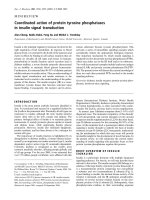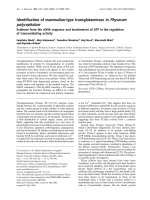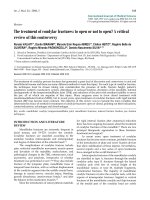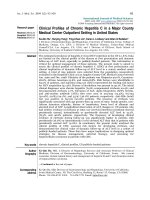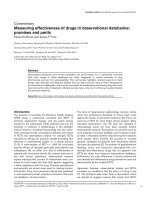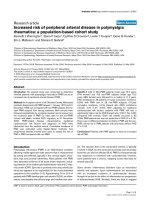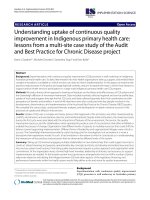Báo cáo y học: "The effectiveness of ENAR® for the treatment of chronic neck pain in Australian adults: a preliminary single-blind, randomised controlled trial" potx
Bạn đang xem bản rút gọn của tài liệu. Xem và tải ngay bản đầy đủ của tài liệu tại đây (494.37 KB, 11 trang )
BioMed Central
Page 1 of 11
(page number not for citation purposes)
Chiropractic & Osteopathy
Open Access
Research
The effectiveness of ENAR
®
for the treatment of chronic neck pain
in Australian adults: a preliminary single-blind, randomised
controlled trial
Andrew L Vitiello*, Rodney Bonello and Henry Pollard
Address: Macquarie Injury Management Group, Department of Health & Chiropractic, Macquarie University, North Ryde, Australia
Email: Andrew L Vitiello* - ; Rodney Bonello - ; Henry Pollard -
* Corresponding author
Abstract
Background: Current evidence on electrotherapies for the management of chronic neck pain is either lacking or conflicting. New
therapeutic devices being introduced to the market should be investigated for their effectiveness and efficacy. The ENAR
®
(Electro
Neuro Adaptive Regulator) therapy device combines Western biofeedback with Eastern energy medicine.
Methods: A small, preliminary randomised and controlled single-blinded trial was conducted on 24 participants (ten males, 14
females) between the ages of 18 to 50 years (median age of 40.5) Consent was obtained and participants were randomly allocated
to one of three groups – ENAR, Transcutaneous Electrical Nerve Stimulation (TENS), or control therapy – to test the hypothesis
that ENAR therapy would result in superior pain reduction/disability and improvements in neck function compared with TENS or
control intervention. The treatment regimen included twelve 15-minute treatment sessions over a six week period, followed by
two assessment periods. Visual Analogue Scale (VAS) pain scores, Neck Disability Index (NDI) scores, Patient Specific Functional
Scale (PSFS) scores and Short Form 36v1 (SF-36) quality of life scores reported by participants were collected at each of the
assessments points throughout the trial (0, 6, 12, 18 and 24 weeks).
Results: Eligible participants (n = 30) were recruited and attended clinic visits for 6 months from the time of randomisation. Final
trial sample (n = 24) comprised 9 within the ENAR group, 7 within the TENS group and 8 within the control group. With an overall
study power of 0.92, the ENAR group showed a decrease in mean pain score from measurement at time zero (5.0 ± 0.79 95%CI)
to the first follow-up measurement at six weeks (1.4 ± 0.83 95%CI). Improvement was maintained until week 24 (1.75 ± 0.9 95%CI).
The TENS and control groups showed consistent pain levels throughout the trial (3.4 ± 0.96 95%CI and 4.1 ± 0.9 95%CI
respectively). Wald analysis for pain intensity was significant for the ENAR group (p = 0.01). Six month NDI scores showed the
disability level of the ENAR group (11.3 ± 4.5 95%CI) was approximately half that of either the TENS (22.9 ± 4.8 95%CI) or the
control (29.4 ± 4.5 95%CI) groups. NDI analysis using the Wald method, indicated significant reductions in disability only for the
ENAR group (p = 0.022). PSFS results also demonstrated significantly better performance of ENAR (p = 0.001) compared to both
alternative interventions. Differential means analysis of the SF-36 results favoured ENAR for all of the subscales. Six of the initial
30 participants discontinued the trial protocol.
Conclusion: ENAR therapy participants reported a significant reduction in the intensity of neck pain (VAS) and disability (NDI),
as well as a significant increased function (PSFS) and overall quality of life (SF-36) than TENS or control intervention participants.
Due to the modest sample size and restricted cohort characteristics, future larger and more comprehensive trials are required to
better evaluate the potential efficacy of the ENAR device in a more widely distributed sample population.
Trial Registration:This study has been registered with the Australian Clinical Trials Registry (ACTR): ACTRN012606000438550.
Published: 9 July 2007
Chiropractic & Osteopathy 2007, 15:9 doi:10.1186/1746-1340-15-9
Received: 11 April 2006
Accepted: 9 July 2007
This article is available from: />© 2007 Vitiello et al; licensee BioMed Central Ltd.
This is an Open Access article distributed under the terms of the Creative Commons Attribution License ( />),
which permits unrestricted use, distribution, and reproduction in any medium, provided the original work is properly cited.
Chiropractic & Osteopathy 2007, 15:9 />Page 2 of 11
(page number not for citation purposes)
Background
The overall prevalence of neck pain is approximately 60%
and point prevalence has been estimated to be between
14% and 18% [1-3]. Chronic neck pain is similar to
chronic low back pain in that it is difficult to diagnose,
resistant to common therapeutic interventions, and is a
financial burden on society. A recent Cochrane review
found that "The current evidence on Galvanic current
(direct or pulsed), iontophoresis, Transcutaneous Electri-
cal Nerve Stimulation (TENS), Electronic Muscle Stimula-
tion (EMS), Pulsed Electromagnetic Field (PEMF) and
permanent magnets is either lacking, limited, or conflict-
ing" [4]. Despite the paucity of evidence, electrotherapy
remains a popular treatment modality with new devices
periodically introduced to the market. These products are
largely untested in terms of properly conducted ran-
domised controlled trials.
The Electro Neuro Adaptive Regulator (ENAR) therapy
device is a hand held, battery powered, electrotherapy
device which, although gaining popularity, is untested
and unreported for its clinical efficacy. The manufacturer
claims the device was developed by a team of Russian doc-
tors and scientists at Sochi University in the late 1970s,
the device combines Western electrical biofeedback with
Eastern energy medicine.
This preliminary study investigated the response of people
with non-complicated chronic neck pain (NCCNP) to two
treatments – ENAR and TENS – and one control proce-
dure. NCCNP was defined as neck pain of duration of
three months or longer without referral of pain in the
upper limbs or hand paraesthesia [5]. The aim of the
project was to evaluate if the application of ENAR therapy
resulted in statistically significant changes in the meas-
ured outcomes when compared to the use of TENS or a
control therapy. As outcomes data on the ENAR device
had not been reported in the literature this study formed
a foundation for knowledge relating to the use of this type
of therapy. A methodology was developed which allowed
the assessment of both the short and medium term effects
of ENAR on this sample of people with neck pain.
Aim of this study
The aim of this study was to test a recently released and
largely untested electro-physical therapy (ENAR) in reduc-
ing the symptoms of non complicated chronic neck pain
(NCCNP). In order to facilitate this aim the researchers
collected participant reported, paper based outcome
measure data from a randomly allocated cohort (n = 24)
of chronic neck pain sufferers, including neck pain inten-
sity, neck function, disability and its overall influence on
quality of life.
Methods
A randomised, controlled single-blinded preliminary
study was developed for application in a university clini-
cal teaching setting. Print media advertising in Sydney,
Australia was used from October-November 2003 and,
following application of the inclusion/exclusion criteria,
30 participants were randomly allocated to one of three
groups: ENAR therapy, TENS therapy and control.
Informed consent was obtained and stratified randomisa-
tion was conducted using a freely available and peer
reviewed design method known as urn randomisation [6].
The subject allocation was concealed from all persons
Table 1: Inclusion and Exclusion criteria for participants
Inclusions
Adults from the geographically local population surrounding Sydney, Australia.
Aged between 18 and 50 years.
Chronic neck pain of a minimum 6 weeks duration.
Assessed as non-complicated neck pain, i.e. no sign or symptom implying cervical spine discogenic disease or radiculopathy.
Exclusions
Suspicion of relevant Red Flag Conditions such as; Spinal fractures, Osseous and Cartilaginous infections, Inflammatory Arthritic conditions, and
Malignancy.
Yellow Flag Conditions such as; Non-finalised Workers Compensation or Third Party Insurance Claim, Any other non-finalised compensatory
litigation.
WAD grade 1–4 whiplash injury within the last six months.
Presence of significant vascular disease.
Severe or acute relapse of neck pain within the last three months.
Motor vehicle accident, serious falls or any other accident requiring medical/hospital treatment within the last three months.
Current neurological signs, symptoms or syndromes, e.g. muscle wasting or nerve root signs, epilepsy or paraplegia.
Pregnancy or likelihood of pregnancy within the trial period.
Spinal or orthopaedic surgery within the past two years.
Bowel, or bladder/sexual dysfunction as a result of either lumbar spine or prostate dysfunction
Currently undergoing a course of manual therapy or psychological intervention.
Participants not prepared to attend 12 treatment sessions within the first six weeks and a further three assessment sessions over the next 18
weeks.
Chiropractic & Osteopathy 2007, 15:9 />Page 3 of 11
(page number not for citation purposes)
who had a potential to interact with the trial participants.
Additional File 1 outlines the flow of participants
throughout the trial, including the intervals between out-
comes assessments and the frequency of each treatment
session for each group as set out by the CONSORT guide-
lines(Additional file 2) [7]. A six-week schedule of treat-
ment was administered by trained final year chiropractic
interns at the respective treatment/university outpatient
clinics, to the neck and upper back of participants. ENAR
treatment involved setting the device to an intensity deter-
mined by the individual participant's tolerance and apply-
ing it to the skin in accordance with the directions set out
in the manufacturer's product literature. It was applied
with light pressure to the posterior neck and upper thorax
in gentle stroking movements. TENS was utilised in this
study due to the similarity of its sensory stimulus com-
pared to the ENAR device. Its dimensions, application to
skin regions, and overall potential treatment sensations
were of a similar nature, thereby facilitating a blinded
comparison. For TENS therapy, electrodes were applied to
Table 2: Frequency analysis of participant race
Frequency Percent Valid Percent Percent
Valid asian 5 20.8 20.8 20.8
caucasian 19 79.2 79.2 100.0
Total 24 100.0 100.0
Frequency analysis of participant ageFigure 1
Frequency analysis of participant age.
Table 3: Frequency analysis of participant allocation to each
treatment group
Treatment Groups
Frequency Percent Valid Percent Cumulative
Percent
ValidENAR937.537.5 37.5
TENS729.229.2 66.7
SHAM 8 33.3 33.3 100.0
Total 24 100.0 100.0
Chiropractic & Osteopathy 2007, 15:9 />Page 4 of 11
(page number not for citation purposes)
the skin overlying the posterior surface of the neck and
upper thorax regions, matching the area stimulated by the
ENAR. Dosage was set to comfortable tolerance level set
below muscle fasciculation response. For the control
group, the ENAR device was used and applied in an iden-
tical manner to the ENAR therapy group except that the
unit was turned on and then immediately off before being
applied to the skin. Prior to commencement of the study
all participants were advised of the potential they may not
feel the electrotherapy during the trial, thereby minimis-
ing any perception of a treatment either occurring or not.
Each of the groups received 10 minutes of their respective
therapy, including the control group according to the
schedule outlined in Additional File 1. Visual Analogue
Scale (VAS) pain scores [8], Neck Disability Index (NDI)
scores [9], Patient Specific Functional Scale (PSFS) scores
[10] and Medical Outcomes Study 36-Item Health Survey
Version 1 (
©
1988, 2002 Medical Outcomes Trust & Qual-
ityMetric Incorporated) (SF-36) [11] scores reported by
participants were collected during weeks 1, 6, 12, 18 and
24 of the trial. Each of these indices were measured both
immediately before and after the treatment administra-
tion period (weeks 1 and 6) and on each six weekly inter-
vals until 24 weeks had elapsed (weeks 12, 18 and 24).
This enabled measurement of the short and medium term
effects of the therapy [5]. A separate group of assessment
administrators was created. The administrators were
blinded as to which intervention each participant received
and were only concerned with ensuring all questionnaires
were filled correctly and tabulating data for independent
analysis. This was designed to address the potential for
participants becoming unblinded as to the type of therapy
being delivered.
The Human Ethics Committee of Macquarie University
approved this study prior to commencement. Further, the
study design complies with Australian National Health
and Medical Research Council's National Statement on
Ethical Conduct in Research Involving Humans [12] and
with the Helsinki Declaration [13] on Human Research.
Of the 30 participants consenting to participate in the
trial, 24 continued to the end of the phase 1 stage of the
study. This equated to an overall participation rate of
80%. For group allocation, all subjects were randomised
using the Urn Randomising Software
®
program (Stout
1994- Project Match- University of Connecticut Health
Mean pain intensity (VAS) scores for each interventionFigure 2
Mean pain intensity (VAS) scores for each intervention.
Chiropractic & Osteopathy 2007, 15:9 />Page 5 of 11
(page number not for citation purposes)
Centre) and each subject was allocated a Trial Participant
Number (TPN) to allow blinding during the clinical trial.
Data were tabulated and statistically analysed using Gen-
Stat
®
(v 9.0) 2006 and SPSS
®
(v13) 2005 software pack-
ages. (REML) Linear Mixed Model analysis (with repeated
measures) was performed on pain, disability and func-
tional parameters (CI = 95%) with a Logistic Regression
Analysis (Wald Test for fixed effects) being performed in
order to determine statistical significance between groups.
Descriptive and interferential methods were applied to
the data using a standard significance level (alpha) of 0.05
where applicable. SF-36 data were compiled using the
Clinical Outcomes Evaluation System v3.74 (COES
®
) –
Repatriation Hospital 1996 using standard scoring algo-
rithms and analysis of means and standard deviation in
that program.
Results
Ten males and 14 females completed the trial. The racial
distribution of the cohort is consistent with that reported
in the Australian 2001 Census data of people living in the
same geographical area (Ryde, New South Wales) [14].
Table 2 demonstrates the breakdown of participant race
within the project cohort, Table 3 identifies the allocation
of participants to the individual treatment groups. Figure
1 graphically represents the age distribution of the cohort
with a median age of 40 years.
Figure 2 is a graphic representation of mean pain intensity
scores (VAS) for each intervention group across trial and
follow-up timeframes. The ENAR group presents a
decrease in mean pain scores from the initial measure-
ment at time zero to the first follow-up measurement at
six weeks. This improvement is maintained throughout
the 24 week follow-up period. The TENS and control
treatment groups each maintained consistent pain levels
throughout the trial. The ENAR therapy was successful in
significantly reducing chronic neck pain intensity (p =
0.01) from 5.0 ± 0.79 at baseline to 1.75 ± 0.90 at the 24
week follow-up. The TENS or control groups had no such
reductions in pain intensity.
Table 6 indicates means and standard errors of (NDI) as a
function of intervention type. Smaller numbers indicate
less disability/improved function. The ENAR therapy
Mean Neck Disability Scores (NDI) for each interventionFigure 3
Mean Neck Disability Scores (NDI) for each intervention.
Chiropractic & Osteopathy 2007, 15:9 />Page 6 of 11
(page number not for citation purposes)
group commenced the trial with a similar baseline disabil-
ity status as the control group, but, on average, both these
groups were more disabled (higher score) than the TENS
group at the commencement of the trial. By the conclu-
sion of the trial 24 weeks later, the disability score of the
ENAR group was approximately half that of either the
TENS group or the control group.
Figure 3 is a graphic presentation of the NDI results. All
participants were chronic pain sufferers as determined by
the inclusion criteria. No subject displayed the severe or
complete levels of disability usually associated with acute
injury. Similar results for neck disability were obtained,
showing the TENS and control groups enjoyed no real
benefit from their intervention whilst the ENAR group
reduced their disability index score to less than half of
their initial values during the 24 week trial. In clinical
terms this equates to a change from borderline 'Moderate/
Mild Disability' to borderline 'Mild/No Disability' status.
Participants receiving ENAR therapy had statistically sig-
nificant reductions in NDI scores (p = 0.02). These scores
reduced from 30.8 ± 3 at the beginning of the trial to 11.3
± 4.5 at the 24 week follow-up stage. Over the same 24
week period, participants undergoing either the TENS or
control therapy did not display any statistically significant
reductions in their NDI scores (TENS from 20.3 ± 3.2 to
22.9 ± 4.8, and control from 30.5 ± 3.0 to 29.4 ± 4.5.).
The minimum clinically detectable change in a partici-
pant's presenting symptoms is 10 NDI points, or 10% [9].
As the results indicate, participants receiving either the
TENS or control treatments did not present any clinically
visible improvements after 24 weeks. This is highlighted
by neither of the two groups progressing from the initial
classification of disability throughout the 24 week trial
period. Which is in contrast to the ENAR group, who over
the same 24 week period had both clinically significant
changes in their NDI scores and were also significantly
closer to being classified as having 'No Disability' accord-
ing to the NDI scoring schedule.
Table 8 presents means and standard errors of neck func-
tioning (PSFS) relating to the intervention type. In this
analysis larger scores depict higher levels of function or
functional improvement. The ENAR groups more than
doubled its functional assessment scores, unlike the TENS
group (which resulted in virtually no change in level of
Mean and SE of Patient Specific Functional Scale (PSFS) scoresFigure 4
Mean and SE of Patient Specific Functional Scale (PSFS) scores.
Chiropractic & Osteopathy 2007, 15:9 />Page 7 of 11
(page number not for citation purposes)
function), and the control group (which resulted some
loss of function).
Figure 4 graphically demonstrates the changes in specific
neck function (PSFS) which occurred with each treatment
group over the 24 week trial period. Of particular note is
the statistically significant improvement in overall neck
function in the ENAR group from the beginning of the
trial (3.6 ± .07) until immediately after cessation of treat-
ment (7.7 ± 0.8). These scores continued to steadily
increase during weeks 12 (7.8 ± 0.9), 18 (8.0 ± 0.9) and
24 (8.5 ± 0.9) where significant differences were still evi-
dent (p = 0.001). Participants undergoing either TENS or
control treatments exhibited PSFS scores at week 1(5.5 ±
0.7 and 6.5 ± 07) that did not significantly change at
either the 6 week(6.2 ± 0.9 and 6.7 ± 0.9), 12 week(5.6 ±
1.0 and 5.4 ± 1.0), 18 week(5.0 ± 10. and 6.8 ± 1.0) or 24
week(5.6 ± 1.0 and 6.0 ± 1.0) stages of the trial.
If the minimally clinical detectable change in PSFS score
is 2, that is, a 20% change in the overall PSFS score, [15] a
significant clinical advantage was achieved with the ENAR
treatment over the entire 24 weeks compared to both the
TENS and control therapy options. While the ENAR ther-
apy was successful in improving the participant's neck
function scores by 136% and exhibiting clear clinical
changes, the changes for the TENS and control therapies
were 3.7% and -7.7% respectively for the same 24 week
period.
Analysis of Quality Of Life (QOL) factors was undertaken
using the SF-36 [16]. The analysis presented was graphi-
cally compiled by the COES
®
(Clinical Outcomes Evalua-
tion Software) package developed by the Repatriation
General Hospital's Orthopaedic Unit in association with
the Information Management Division, South Australian
Health Commission (SAHC). No clinical advantage was
noted in any of the eight key indices in either the TENS or
control therapy groups over the 24 week period. By con-
trast, participants receiving the ENAR therapy had signifi-
cant clinical improvements in all eight subscales of the SF-
36 questionnaire over the same 24 week period.
The QOL SF-36 data indicates the ENAR treatment partic-
ipants scored better than their TENS and control counter-
parts on each of the eight measured subscales. Of
particular note, the ENAR group equalled or outper-
formed the 1995 ABS NHS normative values particularly
when comparing the 'Role Emotional' and 'Social Func-
tioning' psychometric parameters.
Mean SF-36 scores and national normsFigure 5
Mean SF-36 scores and national norms.
Chiropractic & Osteopathy 2007, 15:9 />Page 8 of 11
(page number not for citation purposes)
The reduction in the mean VAS scores is an indicator of
success when compared to the lack of VAS reduction in
the TENS or control therapy. The ongoing reduction of the
VAS score beyond the 6 week period is a clinically useful
finding in this chronic pain cohort.
To better understand the dose response characteristics of
ENAR more frequent measurements of pain, treatment
times and treatment frequency should be investigated. It
is unknown whether equal success could be gained over a
lesser treatment period. Conversely, a longer treatment
regimen of eight or ten weeks may generate greater or
longer lasting treatment effects and lead to further pain
reduction. The potential value of follow-up periods of
therapy was not investigated during this trial though it
was interesting to find significant short/medium term
pain reduction and improvements in other outcomes
measures.
Such conjecture will remain unanswered until further tri-
als are conducted using varying treatment variables. A fol-
low-up trial, with participants given ongoing or
subsequent ENAR treatment blocks, may uncover further
effects of any additional treatment sessions. Although
rarely performed in similar neck pain research, such stud-
ies can be important in determining the ultimate value of
a therapy in chronic conditions unlikely to resolve in the
short term and under what treatment schedule it is best
applied.
The strength of the results were somewhat weakened due
to the influence of larger variations in scores associated
with the small sample sizes during weeks 12–24. Despite
this, the reductions in mean VAS values in the ENAR
group were maintained.
In assessing any therapy whilst obtaining a statistically sig-
nificant result is important, a far more relevant indicator
of ultimate usefulness is the determination of clinical sig-
nificance. A clinically significant decrease in pain levels
has been quantified a 36% reduction in a VAS scale [17].
In a clinical setting this equates to a reduction of 24 mm
along a 100 mm scale. The participants receiving the
ENAR therapy had demonstrable reductions in pain
intensity immediately after the six week treatment period
(from VAS 5.0 to 1.4 equalling a 72% reduction). This
effect continued with reductions in measured outcomes
after 24 weeks when compared to their initial presenta-
tion (from 5.0 to 1.8 equalling a 64% reduction). Other
authors find different levels of change to be clinically rel-
evant. Gallagher concludes a 13 mm difference on the VAS
represents the smallest measurable change in pain severity
that is clinically important [18]. Dickson [19] reports a 13
mm VAS change (i.e. at least 38%) represents a clinically
significant change in pain when the initial VAS score is
less than 34 mm. However, among participants with ini-
Table 5: Wald statistic for VAS (Pain)
Fixed term Wald statistic d.f. Wald/d.f. P
Time 10.39 4 2.60 0.034
RxGroup 1.34 2 0.67 0.512
Time_RxGroup 20.07 8 2.51 0.010*
Table 4: VAS (Pain) means and standard errors as a function of intervention
95% Confidence Interval
Intervention Assessment Mean Std. Error Lower Bound Upper Bound
ENAR Initial consultation 5.000 .789 3.354 6.646
6 week follow-up 1.438 .829 293 3.168
12 week follow-up 2.125 .981 .078 4.172
18 week follow-up 2.188 .813 .492 3.883
24 week follow-up 1.750 .896 119 3.619
TENS Initial consultation 3.243 .844 1.483 5.003
6 week follow-up 3.643 .887 1.793 5.493
12 week follow-up 3.214 1.049 1.026 5.402
18 week follow-up 4.500 .869 2.688 6.312
24 week follow-up 3.429 .958 1.431 5.427
SHAM Initial consultation 3.250 .789 1.604 4.896
6 week follow-up 3.250 .829 1.520 4.980
12 week follow-up 3.438 .981 1.391 5.484
18 week follow-up 4.063 .813 2.367 5.758
24 week follow-up 4.063 .896 2.194 5.931
Chiropractic & Osteopathy 2007, 15:9 />Page 9 of 11
(page number not for citation purposes)
tial VAS scores of at least 67 mm, a 28 mm change (i.e.
42%) is required to represent a clinically significant
change in pain. Ideally, the results of this study should be
reproduced with longer term follow-up and a greater
number of participants to determine the length of the
treatment effect in the absence of ongoing treatment.
Reduction in VAS scores were not observed in participants
receiving either the TENS or the control therapy over the
24 week trial period.
The benefit of this program is its standardisation and sim-
plification of overall administration and scoring of the
Quality of Life (QOL) SF-36 questionnaire's eight key
components – physical functioning (PF), role physical
(RP), bodily pain (BP), general health (GH), vitality (VT),
social functioning (SF), role emotional (RE) and mental
health (MH) – and its comparison of results to average
Australian values collected during the 1995 Australian
Bureau of Statistics National Health Survey (1995 ABS
NHS) [20]. With respect to the relative impact of ENAR
treatment on QOL SF-36 indicators, participants receiving
the ENAR therapy displayed significant clinical improve-
ments in all aspects of the SF-36 questionnaire. These
improvements were so considerable that the 'Role Emo-
tional' and 'Mental Health' components of the ENAR
cohort outscored the 1995 Australian population norms.
However, considering the relatively small sample size,
care must be exercised when comparing the results with
large non-specific population datasets such as the Austral-
ian NHS data. This is a significant achievement in a pop-
ulation of people with chronic pain and perhaps serves to
reinforce that chronic pain syndromes have strong psy-
chosocial impact and such impact may also be affected by
reduced pain.
Limitations of this study
The study has limitations. The first limitation is the mod-
est sample size of 24 participants. Despite this, the authors
present real and statistically significant positive trends
relating to the ENAR therapy in treating people with
NCCNP. As this was a preliminary study discussion of
these results in a wider context of NCCP should be limited
to the focused sample size investigated.
A second limitation of this study was its lack of blinding
of the practitioners delivering the therapies. This was due
to the inability of providing a device, in this case a TENS
unit, that was physically identical to the ENAR device in
order that the therapy administrators could be blinded as
to the exact intervention being given to the participant.
Table 7: Wald statistic for NDI
Fixed term Wald statistic d.f. Wald/d.f. P
Time 14.50 4 3.63 0.006
RxGroup 5.23 2 2.62 0.073
Time_RxGroup 17.93 8 2.24 0.022*
Table 6: NDI means and standard errors as a function of intervention
95% Confidence Interval
Intervention Assessment Mean Std. Error Lower Bound Upper Bound
ENAR Initial consultation 30.750 3.001 24.490 37.010
6 week follow-up 19.113 3.448 11.920 26.305
12 week follow-up 17.250 4.303 8.275 26.225
18 week follow-up 15.000 3.857 6.955 23.045
24 week follow-up 11.250 4.511 1.840 20.660
TENS Initial consultation 20.286 3.208 13.594 26.978
6 week follow-up 19.714 3.686 12.025 27.404
12 week follow-up 21.143 4.600 11.548 30.738
18 week follow-up 26.571 4.123 17.971 35.172
24 week follow-up 22.857 4.823 12.797 32.917
SHAM Initial consultation 30.500 3.001 24.240 36.760
6 week follow-up 21.500 3.448 14.307 28.693
12 week follow-up 27.625 4.303 18.650 36.600
18 week follow-up 26.500 3.857 18.455 34.545
24 week follow-up 29.375 4.511 19.965 38.785
Chiropractic & Osteopathy 2007, 15:9 />Page 10 of 11
(page number not for citation purposes)
The authors determined an adequate solution to this lim-
itation would be to provide a separate 'assessment admin-
istrator' who would be blinded as to the intervention
given to the participant and only gather outcomes based
information on weeks 1, 6, 12, 18 and 24 as well as tabu-
lating data for independent statistical analysis. Future
studies should be directed towards providing a device that
could function as both a TENS and ENAR.
Thirdly, researchers who embark on prospective clinical
trials are acutely aware of the randomisation tool to main-
tain groups with similar baseline characteristics. Using
human participants, who for any number of reasons may
withdraw from a study, make the maintenance of
"matched" groups a tenuous goal. In this study, there were
differences between groups for the variable of race. How-
ever, there is neither recent nor significant evidence sup-
porting the premise that there may be significant
differences in NCCNP rates between different sub-popula-
tions (Anglo-Saxon, Australian Aboriginal, Asian, African,
American, etc). The authors suggest the sample groups
after the participant drop-out, although somewhat differ-
ent at baseline, were sufficiently homogeneous with
regard to the racial breakdown (Asian vs Anglosaxon) to
be regarded as equal. Age, sex, and chronicity of study par-
ticipants were not martched in this study and should be
addressed in greater detail in future studies.
Fourthly, the authors acknowledge the more stringent
intention to treat (ITT) analysis was not performed on this
cohort and consider it a limitation of the study. 24 of the
30 initial participants that consented to participate in the
trial, actually completed the entire protocol. Those who
discontinued included one from the ENAR treatment
group who could not maintain the regular treatment
schedule determined by the testing protocol. From the
TENS group one participant discontinued due to unex-
pected time scheduling constraints while two others due
to a worsening of their neck pain symptoms. Within the
control group, two participants failed to continue due to
a worsening of their neck pain symptoms. No other
adverse reactions were reported by the participants as a
result of either the ENAR or TENS interventions during the
trial period. Due to the premature departure of six partic-
ipants data for an ITT analysis could not be gathered,
resulting in all data being analysed on a per protocol basis
[21]. In future studies an early data collection point, per-
haps 2 or 3 weeks in to the 6 week regime could be used
to establish trend with an ITT analysis. However, because
withdrawals from the TENS and Control groups were
mostly due to worsening symptoms, it is likely that an ITT
analysis would have further favoured the ENAR interven-
tion.
Much of the treatment rendered by practitioners for neck
pain is pharmacologic, manual, exercise of multimodal in
nature [22]. Further studies should consider the role of
Table 9: Wald Statistic for PSFS
Fixed term Wald statistic d.f. Wald/d.f. P
Time 23.20 4 5.80 <0.001
RxGroup 1.89 2 0.95 0.388
Time_RxGroup 34.25 8 4.28 <0.001*
Table 8: PSFS means and standard errors as a function of intervention
95% Confidence Interval
Intervention Assessment Mean Std. Error Lower Bound Upper Bound
ENAR Initial consultation 3.566 .699 2.102 5.030
6 week follow-up 7.712 .848 5.937 9.488
12 week follow-up 7.762 .913 5.853 9.672
18 week follow-up 8.025 .911 6.118 9.932
24 week follow-up 8.475 .943 6.502 10.448
TENS Initial consultation 5.371 .748 3.806 6.936
6 week follow-up 6.157 .907 4.259 8.055
12 week follow-up 5.586 .976 3.544 7.627
18 week follow-up 5.014 .974 2.975 7.053
24 week follow-up 5.614 1.008 3.505 7.723
SHAM Initial consultation 6.529 .748 4.964 8.094
6 week follow-up 6.657 .907 4.759 8.555
12 week follow-up 5.443 .976 3.401 7.485
18 week follow-up 6.757 .974 4.718 8.796
24 week follow-up 5.957 1.008 3.848 8.066
Chiropractic & Osteopathy 2007, 15:9 />Page 11 of 11
(page number not for citation purposes)
ENAR as an alternative or in combination with these more
traditional therapies.
Conclusion
In this small trial, participants who received ENAR ther-
apy experienced greater reductions in the intensity of neck
pain and disability, and increased function and overall
quality of life, compared with participants receiving either
TENS therapy or placebo electrotherapy.
Competing interests
The authors and their employing institution have no com-
mercial stake in the research or its outcomes other than
being recipients of the research grant to perform the inves-
tigation. They did not receive any direct financial benefits
from the potential success or otherwise that may result
from the use or marketing of the therapy in question.
Authors' contributions
ALV conceived the study, participated in its design, col-
lected data and co-ordinated and helped draft the manu-
script.
RB participated in its design, collected data and co-ordi-
nated and helped draft the manuscript.
HP participated in its design and co-ordinated and helped
draft the manuscript.
Each of the authors read and approved the final manu-
script.
Additional material
Acknowledgements
This study was funded by Enlightened Therapies Pty Ltd (ABN 96 099 251
117), a distributor of the product within Australia.
References
1. Wilson S: A synopsis of Bronfort's study published in Critically
appraised papers. Aust J Physiother 2001, 47:4.
2. Gordon SJ, Trott P, Grimmer KA: Waking cervical pain and stiff-
ness, headache, scapular or arm pain: Gender and age
effects. Aust J Physiother 2002, 48:9-15.
3. Cote P, Cassidy JD, Carroll LJ, Kristman V: The annual incidence
and course of neck pain in the general population: a popula-
tion-based cohort study. Pain 2004, 112(3):267-273.
4. Kroeling P, Gross A, Goldsmith CH, Cervical Overview Group: Elec-
trotherapy for neck disorders. Cochrane Database of Systematic
Reviews 2005. Art. No.: CD004251. DOI: 10.1002/
14651858.CD004251.pub3
5. Forestier R, Francon A, Saint Arroman F, Bertolino C, Graber-Duv-
ernay B, Guillemon A, Slikh M: Are SPA therapy andpulsed elec-
tromagnetic field therapy effective for chronic neck pain?
Randomised clinical trial. Ann Readapt Med Phys 2006 in press.
6. Schouten HJ: Adaptive biased urn randomization in small
strata when blinding is impossible. Biometrics 1995,
51(4):1529-1535.
7. Egger M, Jüni P, Bartlett C: Value of Flow Diagrams inReports of
Randomized Control Trials. JAMA 2001, 285:1996-1999.
8. McCormack HM, Horne DJ, Sheather S: Clinical applications of
visual analogue scales: a critical review. Pshycol Med 1998,
18(4):1007-1019.
9. Vernon H, Mior S: The Neck Disability Index: A Study of Reli-
ability and Validity. J Manipulative Physiol Ther 1991,
14(7):409-415.
10. Pietrobon R, Coeytaux RR, Carey TS, Richardson WJ, DeVellis RF:
Standard Scales for measurement of functional outcome for
cervical pain or dysfunction: a systematic review. Spine
27(5):515-522. 2002 Mar 1
11. Ware JE Jr, Sherbourne CD: The MOS 36-item short-form
health survey (SF-36). Conceptual framework and item
selection. Med Care 1992, 30(6):473-83.
12. National Health and Medical Research Council (NHMRC): National
Statement on Ethical Conduct in Research Involving Humans Canberra:
AusInfo; 1999.
13. World Medical Association: Declaration of Helsinki: ethical principals for
research involving human subjects. As amended in Tokyo, 2004 Ferney-
Voltaire, France: The Association; 2004.
14. Australian Government: Australian Bureau of Statistics 2001, 'Ryde (C)
(Statistical Local Area), Basic Community Profile' [ />websitedbs/d3310114.nsf/home/Census%20data]. viewed November
2006
15. Stratford P, Gill C, Westaway M, Binkley J: Assessing Disability
and Change on Individual Patients: A Report of a Patient
Specific Measure. Physiother Can 1995, 47:258-263.
16. Goertz CMH: Measuring Functional Health Status in the Chi-
ropractic Office Using Self-Report Questionnaires. Topics in
Clinical Chiropractic 1994, 1(1):51-59.
17. Fosnocht DE, Swanson ER, Davis J, Bossart P: Percent change in
VAS that is clinically significant for pain relief. Acad Emerg Med
2002, 9(5):407.
18. Gallagher EJ, Liebman M, Bijur PE: Prospective validation of clini-
cally important changes in pain severity measured on a vis-
ual analog scale. Ann Emerg Med 2001, 38:633-638.
19. Dickson EW: Clinically significant changes in pain along the
visual analog scale. Ann Emerg Med 2001, 38:639-643.
20. Australian Government: Year Book Australia 2005. Ref 1301.0 ABS;
2005:63-64.
21. Wang D, Bakhai A: Clinical Trials: a practical guide to design,
analysis, and reporting. London: Remedica; 2006:456-457.
22. Australian Acute Musculoskeletal Pain Guidelines Group: Evidence-
based Management of Acute Musculoskeletal Pain. :85-7
[ />]. viewed 03 April 2007
Additional file 1
Study Protocol. Figure showing the flow of three participant groups
through the trial.
Click here for file
[ />1340-15-9-S1.doc]
Additional file 2
The Consort Flowchart. This figure depicts the standardised protocol show-
ing enrolment, allocation, follow-up and analysis stages of the trial.
Click here for file
[ />1340-15-9-S2.doc]
